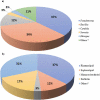Microbial biosurfactants: a review of recent environmental applications
- PMID: 35674010
- PMCID: PMC9275870
- DOI: 10.1080/21655979.2022.2074621
Microbial biosurfactants: a review of recent environmental applications
Abstract
Microbial biosurfactants are low-molecular-weight surface-active compounds of high industrial interest owing to their chemical properties and stability under several environmental conditions. The chemistry of a biosurfactant and its production cost are defined by the selection of the producer microorganism, type of substrate, and purification strategy. Recently, biosurfactants have been applied to solve or contribute to solving some environmental problems, with this being their main field of application. The most referenced studies are based on the bioremediation of contaminated soils with recalcitrant pollutants, such as hydrocarbons or heavy metals. In the case of heavy metals, biosurfactants function as chelating agents owing to their binding capacity. However, the mechanism by which biosurfactants typically act in an environmental field is focused on their ability to reduce the surface tension, thus facilitating the emulsification and solubilization of certain pollutants (in-situ biostimulation and/or bioaugmentation). Moreover, despite the low toxicity of biosurfactants, they can also act as biocidal agents at certain doses, mainly at higher concentrations than their critical micellar concentration. More recently, biosurfactant production using alternative substrates, such as several types of organic waste and solid-state fermentation, has increased its applicability and research interest in a circular economy context. In this review, the most recent research publications on the use of biosurfactants in environmental applications as an alternative to conventional chemical surfactants are summarized and analyzed. Novel strategies using biosurfactants as agricultural and biocidal agents are also presented in this paper.
Keywords: Bioremediation; biosurfactant; environmental applications; heavy metals; hydrocarbons; soil.
Conflict of interest statement
No potential conflict of interest was reported by the author(s).
Figures



Similar articles
-
Biosurfactant is a powerful tool for the bioremediation of heavy metals from contaminated soils.J Hazard Mater. 2021 Sep 15;418:126253. doi: 10.1016/j.jhazmat.2021.126253. Epub 2021 Jun 2. J Hazard Mater. 2021. PMID: 34119972 Review.
-
Biosurfactants during in situ bioremediation: factors that influence the production and challenges in evalution.Environ Sci Pollut Res Int. 2017 Sep;24(26):20831-20843. doi: 10.1007/s11356-017-9778-7. Epub 2017 Aug 16. Environ Sci Pollut Res Int. 2017. PMID: 28815413 Review.
-
Biosurfactant: A new frontier for greener technology and environmental sustainability.Ecotoxicol Environ Saf. 2019 Nov 30;184:109607. doi: 10.1016/j.ecoenv.2019.109607. Epub 2019 Sep 7. Ecotoxicol Environ Saf. 2019. PMID: 31505408 Review.
-
Efficiency of lipopeptide biosurfactants in removal of petroleum hydrocarbons and heavy metals from contaminated soil.Environ Sci Pollut Res Int. 2013 Oct;20(10):7367-76. doi: 10.1007/s11356-013-1752-4. Epub 2013 May 17. Environ Sci Pollut Res Int. 2013. PMID: 23681773
-
Sustainable biosurfactant produced by Serratia marcescens UCP 1549 and its suitability for agricultural and marine bioremediation applications.Microb Cell Fact. 2019 Jan 4;18(1):2. doi: 10.1186/s12934-018-1046-0. Microb Cell Fact. 2019. PMID: 30609918 Free PMC article. Review.
Cited by
-
Cutting-edge perspectives on biosurfactants: implications for antimicrobial and biomedical applications.3 Biotech. 2024 Dec;14(12):297. doi: 10.1007/s13205-024-04146-9. Epub 2024 Nov 11. 3 Biotech. 2024. PMID: 39539528 Review.
-
Bacterial-derived surfactants: an update on general aspects and forthcoming applications.Braz J Microbiol. 2023 Mar;54(1):103-123. doi: 10.1007/s42770-023-00905-7. Epub 2023 Jan 20. Braz J Microbiol. 2023. PMID: 36662441 Free PMC article. Review.
-
Involvement of the Bacillus SecYEG Pathway in Biosurfactant Production and Biofilm Formation.Int J Microbiol. 2024 May 2;2024:6627190. doi: 10.1155/2024/6627190. eCollection 2024. Int J Microbiol. 2024. PMID: 38725978 Free PMC article.
-
Larvicidal and anti-termite activities of microbial biosurfactant produced by Enterobacter cloacae SJ2 isolated from marine sponge Clathria sp.Sci Rep. 2023 Sep 13;13(1):15153. doi: 10.1038/s41598-023-42475-6. Sci Rep. 2023. PMID: 37704703 Free PMC article.
-
Design of TiO2-Based Hybrid Systems with Multifunctional Properties.Molecules. 2023 Feb 16;28(4):1863. doi: 10.3390/molecules28041863. Molecules. 2023. PMID: 36838853 Free PMC article.
References
-
- Pontevedra-Pombal X, Mighall TM, Nóvoa-Muñoz JC, et al. Five thousand years of atmospheric Ni, Zn, As, and Cd deposition recorded in bogs from NW Iberia: prehistoric and historic anthropogenic contributions. J Archaeol Sci. 2013;40(1):764–777.
-
- Singh R, Rathore D.. Impact assessment of azulene and chromium on growth and metabolites of wheat and chilli cultivars under biosurfactant augmentation. Ecotoxicol Environ Saf. 2019;186:109789. - PubMed
-
- Bezza FA, Chirwa EMN. Biosurfactant-enhanced bioremediation of aged polycyclic aromatic hydrocarbons (PAHs) in creosote contaminated soil. Chemosphere. 2016;144:635–644. - PubMed
-
- Wei Z, Wang JJ, Gaston LA, et al. Remediation of crude oil-contaminated coastal marsh soil: integrated effect of biochar, rhamnolipid biosurfactant and nitrogen application. J Hazard Mater. 2020;396:122595. - PubMed
-
- Da Rocha Junior RB, Meira HM, Almeida DG, et al. Application of a low-cost biosurfactant in heavy metal remediation processes. Biodegradation. 2019;30(4):215–233. - PubMed
Publication types
MeSH terms
Substances
Grants and funding
LinkOut - more resources
Full Text Sources
Other Literature Sources
